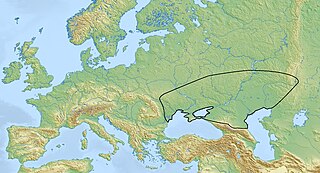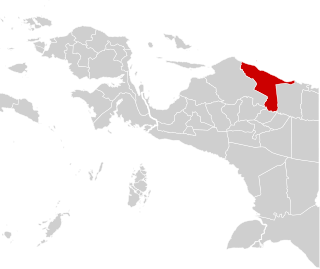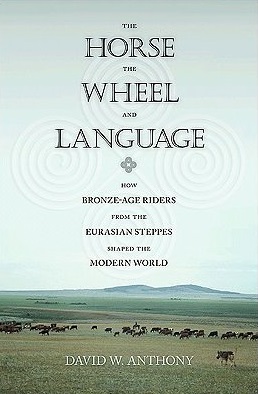Related Research Articles
The 35th century BC in the Near East sees the gradual transition from the Chalcolithic to the Early Bronze Age. Proto-writing enters transitional stage, developing towards writing proper. Wheeled vehicles are now known beyond Mesopotamia, having spread north of the Caucasus and to Europe.

The Yamnaya culture or the Yamna culture, also known as the Pit Grave culture or Ochre Grave culture, was a late Copper Age to early Bronze Age archaeological culture of the region between the Southern Bug, Dniester, and Ural rivers, dating to 3300–2600 BCE. It was discovered by Vasily Gorodtsov following his archaelogical excavations near Siversky Donets in 1901—1903. Its name derives from its characteristic burial tradition: Я́мная is a Russian adjective that means 'related to pits ', as these people used to bury their dead in tumuli (kurgans) containing simple pit chambers.

The Maykop culture, c. 3700 BC–3000 BC, was a major Bronze Age archaeological culture in the western Caucasus region.
The Sarmi-Jayapura Bay languages consist of half a dozen languages spoken on the northern coast of Papua province of Indonesia:

The SeredniiStihculture is a pre-Kurgan archaeological culture from the 5th-4th millennia BC. It is named after the Dnipro River islet of today's Seredny Stih, Ukraine, where it was first located.
Yamna may refer to:

The Samara culture was an Eneolithic culture that flourished around the turn of the 5th millennium BCE, at the Samara Bend of the Volga River. The Samara culture is regarded as related to contemporaneous or subsequent prehistoric cultures of the Pontic–Caspian steppe, such as the Khvalynsk, Repin and Yamna cultures. The Proto-Indo-European homeland is often linked to one or more of these cultures.

The Pontic–Caspian steppe, formed by the Caspian steppe and the Pontic steppe, is the steppeland stretching from the northern shores of the Black Sea to the northern area around the Caspian Sea. It extends from Dobruja in the northeastern corner of Bulgaria and southeastern Romania, through Moldova and southern and eastern Ukraine, across the Russian Northern Caucasus, the Southern and lower Volga regions to western Kazakhstan, adjacent to the Kazakh steppe to the east, both forming part of the larger Eurasian Steppe. It forms a part of the Palearctic realm and of the temperate grasslands, savannas, and shrublands biome.
YMN or ymn may refer to:
Jamna Dolna is a non-existing village in the administrative district of Gmina Ustrzyki Dolne, within Bieszczady County, Subcarpathian Voivodeship, in south-eastern Poland. It lies approximately 23 kilometres (14 mi) north of Ustrzyki Dolne and 61 km (38 mi) south-east of the regional capital Rzeszów.

Sarmi Regency is one of the regencies (kabupaten) in Papua Province of Indonesia. It was formed from the western districts then within Jayapura Regency with effect from 12 November 2002. It covers an area of 18,034.0 km2, and had a population of 32,971 at the 2010 Census and 41,515 at the 2020 Census; the official estimate as at mid 2021 was 41,849. The regency's administrative centre is at the town of Sarmi.

The 8th European Cross Country Championships were held at Thun in Switzerland on 9 December 2001. Serhiy Lebid took his second title in the men's competition and Yamna Belkacem won the women's race.

The Horse, the Wheel, and Language: How Bronze-Age Riders from the Eurasian Steppes Shaped the Modern World is a 2007 book by the anthropologist David W. Anthony, in which the author describes his "revised Kurgan theory." He explores the origins and spread of the Indo-European languages from the Pontic–Caspian steppe throughout Western Europe, Central Asia, and South Asia. He shows how the domesticated horse and the invention of the wheel mobilized the steppe herding societies in the Eurasian Steppe, and combined with the introduction of bronze technology and new social structures of patron-client relationships gave an advantage to the Indo-European societies. The book won the Society for American Archaeology's 2010 Book Award.

Yamna Carolina Lobos Astorga is a popular Chilean dancer, television host, and actress.
Bang TV was a Chilean television channel owned by TVI Filmocentro S.A focused on music ranging from the broadcasting of national production, also including genres like Reggaetón, K-pop and pop music.

Yamna Oubouhou is a long-distance runner competing internationally for France. She first competed in the track events before moving up to the marathon.
Blandine Bitzner-Ducret is a former French athlete who specialized in distance races and cross-country.
Rakiya Maraoui Quétier is a Moroccan-born French former long-distance runner who competed mainly in the marathon and cross country running. She competed in the marathon at the World Athletics Championships in 1993 and 2003, and represented France at the 2004 Summer Olympics. She was a three-time participant at the IAAF World Cross Country Championships and ran at the 1998 IAAF World Half Marathon Championships. She was the marathon gold medallist at the 1989 Jeux de la Francophonie. On the road running circuit, she was the winner of the 1990 Roma-Ostia Half Marathon and 2001 Corrida de Houilles

Satsurblia Cave Natural Monument is a paleoanthropological site located 1.2 km from Kumistavi village, Tsqaltubo Municipality, in the Imereti region of Georgia, 287 meters above sea level. The karst cave was first excavated in 1976 by A. N. Kalandadze. In the Middle Ages the cave was used as a refuge.

The Mikhaylovka culture, Lower Mykhaylivka culture is a Copper Age archaeological culture which flourished on the Pontic steppe from 3600 BC to 3000 BC.
References
- ↑ Yamna at Ethnologue (18th ed., 2015) (subscription required)